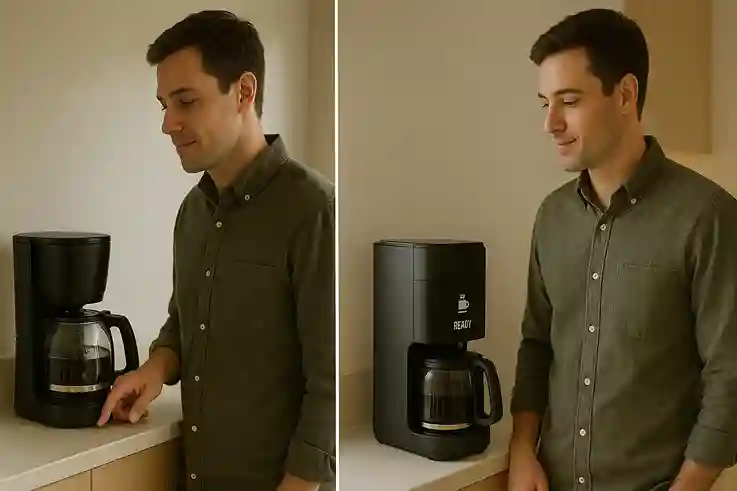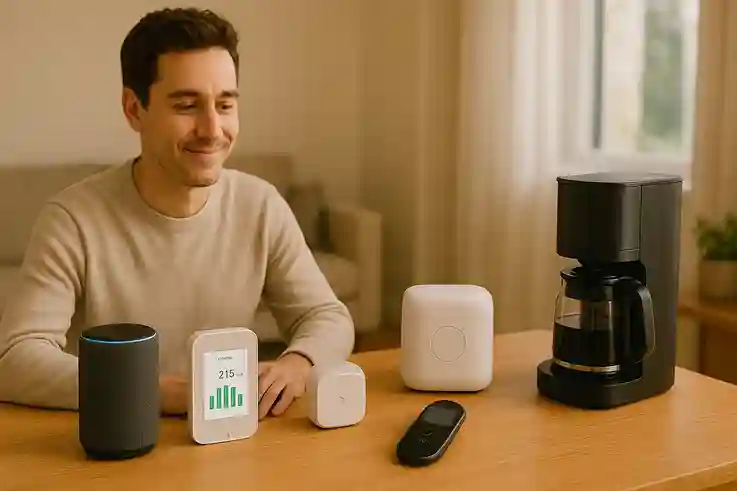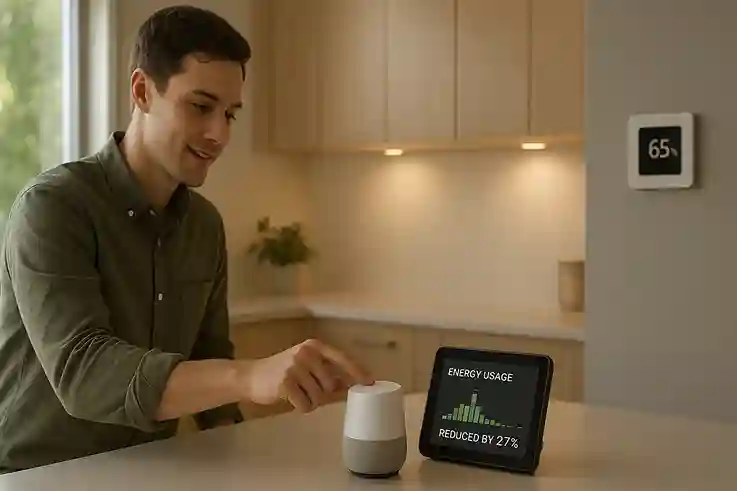Smarter Living with AI Gadgets
AI Gadgets are changing the way we live. They are no longer just futuristic ideas. Today, they help manage tasks at home, at work, and on the go. From smart thermostats to AI-powered assistants, these devices make everyday life easier and more efficient. In a fast-paced world, saving time, money, and energy is more important than ever. AI gadgets automate repetitive tasks, reduce waste, and optimize energy use. They help you focus on what matters most while making smart choices automatically.
This blog will explore practical examples of AI gadgets that truly make a difference. You will see how they simplify chores, cut costs, and save energy. By the end, you’ll know which AI gadgets are worth adding to your daily life.
What Makes AI Gadgets Different?
AI gadgets are smart devices powered by artificial intelligence. They go beyond simple instructions. Unlike traditional gadgets, they don’t just follow commands. They learn from your behavior, adapt to your needs, and improve with continued use.
For example, a voice assistant becomes more accurate the more you interact with it. A cleaning robot maps your home and adjusts routes to work faster. Over time, these devices become more personalized and efficient. This ability to evolve makes AI gadgets different from standard electronic tools.

Learning and Automation
Smart gadgets rely on data to understand how you live. They don’t just perform tasks — they recognize patterns in your daily routine and adjust settings automatically.
For example, a smart thermostat starts by recording when you raise or lower the temperature. Over time, it learns when you wake up, leave for work, or go to sleep. Eventually, it manages heating and cooling on its own, so your home stays comfortable without constant manual input.
The same learning process applies to other devices. A smart lighting system might detect that you prefer dim lights in the evening and bright ones in the morning. A smart speaker could recommend playlists that match your mood or the time of day. Even kitchen appliances are starting to adjust cooking modes based on your past choices.
This level of automation reduces the need for reminders or repetitive actions. Instead of you adapting to technology, the technology adapts to you — creating a personalized, efficient living environment.
Smarter Than Traditional Devices
Traditional devices perform a single fixed function. A basic fan spins at one speed until you change it. A standard light stays on until you switch it off. These tools are useful, but they depend entirely on manual input. AI gadgets go beyond that. They predict your needs before you ask, personalize settings based on your habits, and respond in real time to changes around them. This makes them faster, more efficient, and more helpful in daily life.
Think of a smart fan that adjusts speed automatically as the room warms or cools. Or smart lights that dim gradually as daylight fades. These features not only add comfort but also save energy by avoiding unnecessary use. The difference comes down to adaptability. Traditional devices wait for instructions. AI gadgets anticipate, act quickly, and deliver greater value in everyday routines.
Traditional Devices vs. AI Gadgets
| Feature | Traditional Devices | AI Gadgets |
|---|---|---|
| Functionality | Perform one fixed task exactly as instructed | Adapt to multiple situations and adjust automatically |
| User Input | Require manual control every time | Learn preferences and act with little or no input |
| Response | React only when you make changes | Respond in real time to changes in environment or routine |
| Personalization | Same settings for everyone | Personalized settings based on user habits |
| Efficiency | Can waste energy if left running | Save energy by adjusting intelligently |
| Value in Daily Life | Basic convenience | Greater comfort, automation, and long-term efficiency |
AI Devices That Save Time
Time is one of the most valuable resources in modern life. AI gadgets are designed to handle repetitive or time-consuming tasks, freeing up hours for more important priorities.

Smart Assistants
Devices like voice-controlled smart assistants handle everyday organization with ease. They can schedule meetings, set reminders, send notifications, and even manage shopping lists without you lifting a finger. Instead of juggling apps or calendars, you simply speak a command.
A simple request such as “Remind me to call the doctor at 3 p.m.” replaces the need to type, search, or manually set reminders. Over time, these assistants learn your routines and suggest helpful actions, like reminding you to leave early for a meeting if traffic is heavy.
The result is less time spent on small tasks and more focus on what matters most. For busy professionals, students, or parents, this hands-free support can streamline the day and reduce stress.
AI-Powered Cleaning Robots
Robotic vacuums and mops are no longer futuristic luxuries — they’ve become practical tools for everyday homes. These devices take on one of the most repetitive household chores: floor cleaning. With built-in sensors, they navigate around furniture, avoid obstacles, and cover large areas without supervision. Modern models go beyond simple sweeping. Many can map your home layout, clean specific rooms on command, and adjust suction power depending on the surface. Some even switch between vacuuming and mopping modes for a deeper clean.
When the job is done, the robot doesn’t need guidance. It automatically returns to its charging dock, ready for the next task. What once took an hour of manual effort now happens in the background while you work, relax, or spend time with family.
By offloading cleaning to AI-powered robots, households can reclaim valuable hours each week and enjoy consistently cleaner living spaces with minimal effort.
AI Translation Devices
Language barriers no longer require lengthy dictionary searches or switching between translation apps. Portable AI translators now deliver instant, real-time communication in dozens of languages. With a single device, conversations flow smoothly without pauses or misunderstandings.
These translators are designed for everyday convenience. Travelers can ask for directions, order food, or connect with locals in seconds. Business professionals can negotiate, present ideas, or collaborate with international teams without the delay of manual translation. Many devices even recognize regional accents and slang, making them more accurate than traditional tools.
The result is faster, clearer communication that reduces frustration and opens doors to new opportunities. Whether you’re exploring a foreign city or managing global projects, AI translation devices save time while making interactions more natural and stress-free.
Real-Life Example
Consider the daily routine of a busy working parent. Mornings are often packed with preparing meals, getting children ready for school, and rushing to work. Evenings bring household chores, scheduling tasks, and trying to squeeze in personal time.
AI gadgets ease this pressure. A robotic vacuum keeps floors clean without supervision. A smart assistant manages reminders, appointments, and even grocery lists. An AI translator can help with quick communication at work or while traveling. Together, these tools reduce repetitive tasks and mental load.
The result is hours saved each week. Instead of spending that time cleaning or managing schedules, the parent can invest it in family activities, rest, or personal growth. AI technology doesn’t just make life more efficient — it creates space for what truly matters.
How AI Gadgets Save Time for a Busy Parent
That’s nearly half a day regained each week. Instead of spending valuable time on repetitive tasks, a working parent can redirect those hours to family, rest, or personal growth. AI gadgets don’t just improve efficiency — they create meaningful space for life’s priorities.
| Task | Without AI Gadgets | With AI Gadgets | Time Saved |
|---|---|---|---|
| House Cleaning | Manually vacuuming and mopping floors (about 5–7 hours per week) | Robotic vacuum and mop clean automatically | 5–7 hours |
| Scheduling & Reminders | Manually entering tasks into calendars and apps | Smart assistant manages schedules, reminders, and grocery lists by voice | 2–3 hours |
| Communication | Using translation apps or manual typing for work/travel | AI translator provides instant, real-time communication | 1–2 hours |
| Total Weekly Time Saved | — | — | 8–12 hours |
AI That Save Money
AI technology is not just about convenience — it can also reduce household and personal expenses. By optimizing usage, spotting waste, and preventing costly problems, these gadgets help people save money over time.
Smart Thermostats
Heating and cooling systems often make up the largest share of household utility costs. Traditional thermostats keep running at the same settings until you adjust them, which can waste energy when no one is home. Smart thermostats solve this problem by learning your daily routine. They track when you wake up, leave for work, or go to sleep, and adjust temperatures accordingly. Some models even monitor local weather conditions, lowering energy use on mild days and boosting efficiency during extreme temperatures.
Over time, these small adjustments add up. By preventing unnecessary heating or cooling, smart thermostats can cut electricity bills significantly, saving homeowners money month after month while also reducing overall energy consumption.
AI-Powered Shopping Tools
Online shopping offers endless choices, but it can also feel overwhelming. Prices change frequently, deals disappear quickly, and comparing options manually takes time. This often leads to overspending or missing out on better offers. AI-powered shopping tools make the process smarter. They track prices across multiple platforms, compare similar products, and send alerts when an item drops to its lowest cost. Some even predict price trends, helping you decide whether to buy now or wait for a better deal.
The result is clear: you spend less and buy with more confidence. Instead of second-guessing purchases, you shop at the right time and at the best available price — saving both money and effort.
Predictive Maintenance Devices
Household appliances and home systems often break down without warning, leaving homeowners with costly repairs or replacements. A malfunctioning refrigerator, water heater, or HVAC system can disrupt daily life and create sudden financial strain.
Predictive maintenance devices help prevent these surprises. By monitoring performance in real time, they detect small irregularities — unusual energy use, changes in vibration, or temperature shifts — that signal potential problems. Once detected, the system alerts you before a major failure occurs.
Fixing these minor issues early costs far less than waiting until a complete breakdown. Over time, this proactive approach not only reduces repair bills but also extends the lifespan of appliances, saving money while adding peace of mind.
Real-Life Example
Imagine a homeowner using AI gadgets throughout the year. A smart thermostat lowers heating costs, shopping tools prevent overspending, and maintenance alerts avoid sudden repair bills. Together, these devices help reduce monthly expenses and improve financial stability.
AI Gadgets That Save Energy
AI-powered devices don’t just make life easier — they also help conserve energy. By learning habits, adjusting usage, and eliminating waste, these gadgets reduce both utility bills and environmental impact.
Smart Lighting Systems
Traditional lights stay on until someone switches them off, which often wastes electricity. Smart lighting systems solve this with motion and daylight sensors. They automatically dim or turn off when no one is in the room, and adjust brightness based on natural sunlight, ensuring energy is used only when needed.
AI Energy Monitors
Energy monitors connected to household circuits track real-time consumption. With AI, they go a step further — identifying which devices use the most power and suggesting ways to cut waste. This insight helps households and offices make smarter decisions about daily energy use.
Smart Appliances
Modern appliances like refrigerators, washing machines, and dishwashers now come with AI features that adapt to usage patterns. For example, a smart dishwasher may delay running until energy demand is lower, reducing costs and easing strain on the grid.
Real-Life Example
Consider an office equipped with AI energy tools. Lights switch off automatically in empty meeting rooms, energy monitors highlight wasteful equipment, and smart appliances adjust usage. Together, these changes lower monthly energy consumption, saving money while promoting sustainability.
For more details on how AI gadgets and technologies improve energy efficiency, you can explore this U.S. Department of Energy resource.
How AI Gadgets Improve Daily Life
AI gadgets do more than complete tasks — they improve overall quality of life. By automating routines, offering insights, and freeing up time, they help people focus on what truly matters.

Stress Relief Through Automation
Modern life is filled with constant demands — schedules to track, chores to complete, and reminders to manage. Trying to juggle all of these responsibilities can quickly become overwhelming and mentally draining.
AI gadgets ease this pressure by taking over repetitive tasks. Smart assistants manage calendars, set reminders, and even organize shopping lists through simple voice commands. Cleaning robots quietly handle vacuuming and mopping, keeping homes tidy without supervision. Other AI tools, like smart thermostats or lighting systems, adjust automatically so you don’t have to think about them.
By automating these daily responsibilities, AI gadgets reduce decision fatigue and mental load. Instead of worrying about small tasks, you enjoy a calmer environment and more mental space to focus on priorities that truly matter.
Better Decision-Making with Data Insights
One of the most powerful benefits of AI gadgets is their ability to turn raw data into practical guidance. Instead of leaving you to guess, they provide clear insights that lead to smarter choices in everyday life.
For example, AI energy monitors track electricity use in real time and point out wasteful habits, such as leaving devices on standby. Health trackers go beyond counting steps — they analyze sleep patterns, heart rate, and activity levels, giving personalized wellness recommendations. Shopping tools scan prices across platforms, alerting you to the best deals so you avoid overspending.
By translating complex data into simple, actionable advice, these devices remove uncertainty. Decisions that once felt overwhelming — like how to save energy, when to rest, or what to buy — become easier, faster, and more accurate. With less guesswork, daily life becomes both more efficient and more confident.
More Free Time for Personal or Family Life
Time is one of the most limited resources in daily life, and much of it is often consumed by repetitive chores or small tasks. AI gadgets give this time back by handling routine responsibilities in the background.
Instead of spending hours cleaning, managing reminders, or manually comparing prices, users can let devices do the work. Robotic vacuums clean floors, smart assistants manage schedules, and shopping tools find the best deals automatically. These small time-savers add up to hours reclaimed each week.
The difference is how this saved time can be used. Some people invest it in hobbies or creative pursuits, others in rest and self-care, and many in family activities that strengthen personal connections. In this way, AI technology transforms efficiency into something more valuable — meaningful personal benefits that improve quality of life.
The Future of AI Devices
AI gadgets are still evolving, and the next generation promises even greater impact on everyday life. From personal health to transportation and sustainability, emerging trends show how deeply AI will integrate into our routines.
Wearable Health AI
Future wearables will go beyond step counting. AI-powered health devices will track blood sugar, detect irregular heart rhythms, and even predict potential illnesses before symptoms appear. This level of monitoring could transform preventive healthcare and give individuals more control over their well-being.
Personalized Learning Devices
Education is also being reshaped by AI. Personalized learning gadgets will adapt lessons to each student’s pace, style, and strengths. For children, this means more engaging learning experiences. For adults, it offers efficient ways to upskill or retrain for new careers.
AI in Cars and Smart Cities
Cars are becoming smarter, with AI enabling real-time navigation, predictive maintenance, and even autonomous driving. On a larger scale, smart cities are integrating AI to manage traffic, reduce energy waste, and improve public safety, making urban living more efficient and sustainable.
Sustainable Living Through AI
As climate concerns grow, AI gadgets will increasingly focus on sustainability. Smart energy systems, adaptive appliances, and AI-driven recycling solutions will help households and communities reduce their carbon footprint while cutting costs.
Frequently Asked Questions (FAQ)
Conclusion
AI gadgets are no longer futuristic novelties — they’re practical tools that make daily life easier and more efficient. From saving time through automation, cutting costs with smarter decisions, to reducing energy use for a sustainable lifestyle, these devices are becoming everyday essentials.
As technology advances, AI gadgets will continue to adapt, personalize, and add value to our routines. They are reshaping the way we work, live, and interact with our surroundings.
Which AI gadget would you try first to make your daily life easier? Leave a comment Below

Amber Hexshot is a creative blogger with a specialty in home décor, where she shares fresh ideas on design, styling, and creating inviting spaces. With a keen eye for detail and a love for transforming everyday rooms into inspiring environments, she enjoys helping readers bring beauty and personality into their homes. Beyond décor, Amber also explores other topics such as lifestyle, travel, and personal growth, offering a wide variety of content that resonates with her audience.
When she’s not writing, Amber loves visiting art galleries, experimenting with DIY projects, and discovering unique design trends from around the world. Her approachable tone and practical advice make her blogs both inspiring and easy to follow.


